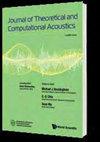基于有限基函数序列的海洋声场近似自动驾驶汽车
IF 1
3区 物理与天体物理
Q3 ACOUSTICS
Journal of Theoretical and Computational Acoustics
Pub Date : 2020-03-01
DOI:10.1142/S2591728519500026
引用次数: 0
摘要
目前正在开发能够使声传感车辆自动绘制声场地图的算法,但有些算法需要对从声场收集的数据进行分析表示,并具有特定的连续性属性。一种满足这些要求并已应用于自主声传感算法的最优控制技术是庞特里亚金最大原理(PMP)。考虑到大多数现实世界的领域都是通过数值方法建模的,需要从数据中创建连续的分析表示是这些自主算法的实际应用中的一个障碍。本文采用有限级数基函数来解决这一问题。选择基函数以满足PMP的标准,并使用所收集的数据来近似场。虽然这种方法符合算法的标准,但对于复杂字段和大型数据集来说,它可能是一种计算成本很高的方法。本文着眼于在精度和计算时间之间的权衡,针对不同的频率和场复杂性水平。根据厄尔巴岛采集的数据,之前发表的海洋剖面在正常模式软件Kraken中使用,以产生用于测试该方法的声场。考虑的候选基函数是类似于有限傅里叶级数的三角函数和勒让德多项式。在低频动态选择排除范围和在高频用三次样条插值方法生成中间数据点时,勒让德多项式具有更高的精度。计算运行时间,虽然两个候选基函数都显示满足PMP算法的要求,但Legendre多项式需要最少的运行时间。本文章由计算机程序翻译,如有差异,请以英文原文为准。
Approximating Ocean Acoustic Fields with Finite Basis Function Series for Autonomous Vehicle Applications
Algorithms that enable acoustic sensing vehicles to autonomously map acoustic fields are being developed, but some require an analytical representation of the data collected from the acoustic field with specific continuity properties. One optimal control technique that has these requirements and has been used in autonomous acoustic sensing algorithms is Pontryagin’s Maximum Principle (PMP). Given that most real-world fields are modeled by numerical methods, the need to create continuous analytical representations from data is a hurdle in realistic applications of these autonomous algorithms. In this work, finite series of basis functions are used to solve this problem. The basis functions are selected to meet the criteria of the PMP, and are used to approximate the field from the data collected. While this approach meets the criteria of the algorithm, it can be a computationally expensive approach for complex fields and large datasets. This paper looks at the trade off between accuracy and computational time, for different frequencies and levels of field complexity. A previously published ocean profile developed from data taken off the island of Elba is used in the normal mode software, Kraken, to generate the acoustic fields used to test this method. The candidate basis functions considered are trigonometric functions analogous to finite Fourier series, and Legendre polynomials. The Legendre polynomials are shown to have higher accuracy when used with a dynamically selected exclusion range at low frequencies and a cubic spline interpolation method for generating intermediate data points at higher frequencies. Run times are calculated and while both candidate basis functions are shown to meet the requirements of the PMP algorithm, the Legendre polynomials require the least amount of run time.
求助全文
通过发布文献求助,成功后即可免费获取论文全文。
去求助
来源期刊

Journal of Theoretical and Computational Acoustics
Computer Science-Computer Science Applications
CiteScore
2.90
自引率
42.10%
发文量
26
期刊介绍:
The aim of this journal is to provide an international forum for the dissemination of the state-of-the-art information in the field of Computational Acoustics.
Topics covered by this journal include research and tutorial contributions in OCEAN ACOUSTICS (a subject of active research in relation with sonar detection and the design of noiseless ships), SEISMO-ACOUSTICS (of concern to earthquake science and engineering, and also to those doing underground prospection like searching for petroleum), AEROACOUSTICS (which includes the analysis of noise created by aircraft), COMPUTATIONAL METHODS, and SUPERCOMPUTING. In addition to the traditional issues and problems in computational methods, the journal also considers theoretical research acoustics papers which lead to large-scale scientific computations.
 求助内容:
求助内容: 应助结果提醒方式:
应助结果提醒方式:


